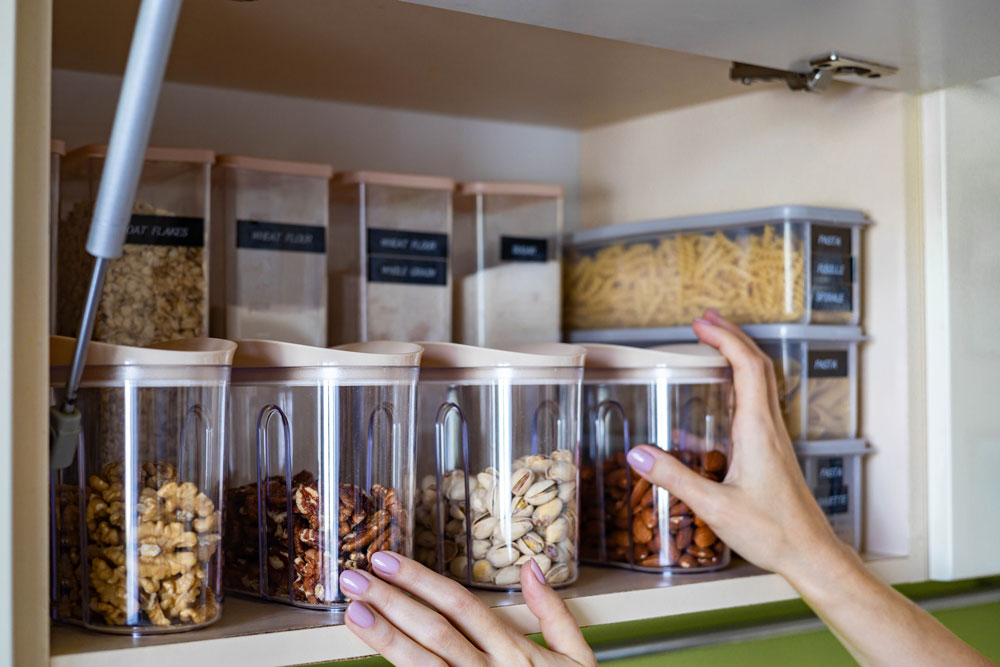How To Get Rid Of Mould In Kitchen Cupboards
 CONTENTS
CONTENTS
- What causes mould in kitchen cupboards?
- What causes mould to grow behind kitchen cupboards?
- The dangers of mould
- How to remove mould in kitchen cupboards
- How to prevent mould in kitchen cabinets and cupboards
- Book your mould cleaning service today
Mould thrives in damp, dark spaces, making your kitchen an ideal space for it to grow. But this fungus is not just an unsightly feature, it can also put your health at risk, particularly if it's growing on or near your food and homeware. Thorough removal by professionals is essential to make your home safe again.
Here at ICE Cleaning, we offer our mould remediation services across the UK. Our technicians have been accredited by Dewpoint Professional, the leading accreditor of mould remediation and prevention, and can therefore remove mould from any domestic or commercial property.
Read on to learn more about why mould is growing in your kitchen cupboards and how to get rid of it.
What causes mould in kitchen cupboards?
Mould is a type of fungus that is caused by excess moisture, whether that is damp, condensation, high humidity, or water damage. Poor ventilation and air flow can exacerbate these conditions, making it an ideal environment for mould to grow.
Certain rooms are more susceptible to mould growth such as kitchens and bathrooms because of the steam produced while cooking or washing which can lead to condensation forming on surfaces.
Kitchen cupboards can become mould hotspots because they often host small leaks or condensation from pipes, creating a cosy haven for spores to settle down and multiply. The closed doors can also trap in humid, stale air. Any crumbs from food provide mould with the organic material it needs to feed off, too.
Another potential cause is liquids stored in cupboards spilling and making the area damp, or wet items being stowed away, such as plates that have not fully dried.
What causes mould to grow behind kitchen cupboards?
The space behind kitchen cupboards provides mould with the damp, dark, and poorly ventilated spaces it loves. The most common cause of mould behind cabinets and kitchen units is the steam generated by cooking sneaking into the space, making the area damp.
Tiny splatters of food and grease can also find their way back there, and provide mould growth with plenty of food. As this space is so difficult to reach and clean, lots of dust can build up, too.
Mould thrives in poor lighting, as well, as UV light can kill it. These dark, hidden spaces provide it with the perfect place to grow and spread without you knowing.
The dangers of mould
Mould produces allergens, irritants, and sometimes even toxic compounds which can cause a range of serious health problems. Inhaling, ingesting, and touching mould can put you at risk of allergic reactions, asthma attacks, lung infections, and sick building syndrome.
People with pre-existing skin and respiratory conditions or a weakened immune system are particularly vulnerable to mould exposure, as well as young children and elderly people.
Mould can be especially harmful in kitchen cupboards. If the mould gets onto your food or kitchenware such as plates and cutlery, you could be regularly consuming it. Given how often we use the kitchen, you will also be inhaling mould when you prepare and eat food.
How to remove mould in kitchen cupboards
No matter how tempting it is, you must not attempt to remove mould yourself. Firstly, most DIY methods are counterproductive and can make the problem worse.
Scrubbing at mould, for instance, may cause spores and toxins to become airborne, encouraging it to spread across the property. The harsh chemicals recommended online, such as bleach, can also damage and discolour surfaces.
Disturbing mould can release spores and toxins into the air, putting the person cleaning it at high risk of inhaling or touching the mould.
Mould can be difficult to clean, too, particularly if it's growing in hard-to-reach areas like in or behind cupboards. Mould removal specialists will have the tools and products to safely eliminate all traces of the mould in your home without damaging your property.
They will be able to diagnose the cause of the mould in your home and advise on how to prevent it returning in the future, as well. They can give you peace of mind that your mould problem is dealt with for good.
How to prevent mould in kitchen cabinets and cupboards
Mould thrives on moisture and darkness, so keeping your kitchen cupboards dry and well-ventilated is key. Have any leaks fixed by professionals immediately and use dehumidifiers to keep humidity levels below 50% in your kitchen.
If you have got an extractor fan, use it when cooking or washing up to get rid of any steam. Open windows, too, to bring in fresh air and push out humid air.
Regular cleaning is key, as well, to get rid of any dust, crumbs, and spillages mould can thrive off. It will also enable you to spot the early signs of mould growth so you can have it removed before it becomes a big problem.
You can learn more about the best ways to prevent mould growth in your home in this blog.
Book your mould cleaning service today
Every mould removal comes with a lifetime guarantee* so if the mould comes back we will remediate it for free. We operate 24/7, 365 days a year, including bank holidays.
You can find out more about our mould removal services by calling our team on 0208 066 0360 or sending them an email at enquiries@icecleaning.co.uk.
*subject to advisories

Speak with me today,
I’m here to help
By asking you a few questions either via phone or email I can immediately provide a realistic estimation of the cost.
You’re in good company. We’ve cleaned for the following commercial clients… View all

Why choose us?
- Cater to a wide variety of cleaning situations
- Nationwide coverage, available 24/7
- Cater to commercial and domestic clients
- Free survey provided prior to quotation
- Emergency response team
- Offer a bespoke service designed to suit all your needs
- All technicians hold professional health and safety qualifications, including BICSc, IOSH, Dewpoint Professional & Safe Contractor
We’re fully accredited
We place best practise, professional expertise and health and safety at the core of our business. We’re fully compliant with all legal obligations. You can view a list of our accreditations below, or visit our Health & Safety page for more information.











-RGB-small.1707319151.jpg)




















